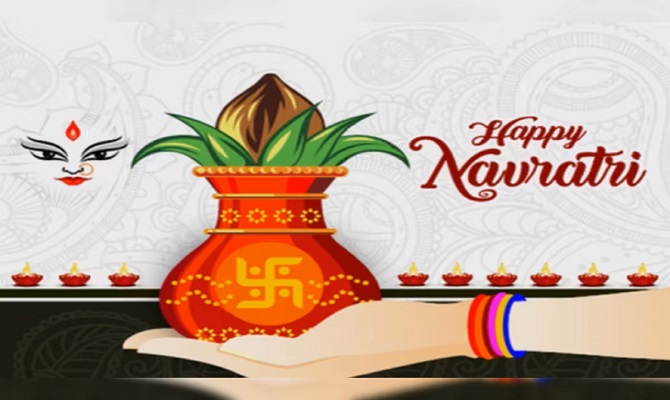Navratri Kalash Sthapana is a Hindu ritual that marks the beginning of the Navratri festival. Navratri is a nine-day festival that celebrates the triumph of good over evil and the worship of the divine feminine energy. The festival is observed twice a year, once in the months of Chaitra (March-April) and once in the months of Ashwin (September-October). The Navratri Kalash Sthapana is performed on the first day of the festival and involves the installation of a Kalash, which is a sacred pot, in the house or temple.

The Navratri Kalash Sthapana ritual involves the preparation of a Kalash, which is a pot made of brass, copper, or silver. The Kalash is filled with water, coconut, and mango leaves and is covered with a cloth. The Kalash is then placed on a bed of rice in the puja room or in a specially prepared area in the house. The Kalash is considered to be a symbol of the goddess Durga, who is worshipped during Navratri.
During the nine-day festival, the Kalash is worshipped every day with offerings of flowers, fruits, and sweets. The puja room is decorated with flowers and lights, and devotees offer prayers and perform aarti to the goddess Durga. The Kalash is also considered to be a symbol of the universal consciousness, and the water in the Kalash is believed to represent the primordial water from which life originated.
The Navratri Kalash Sthapana is an important ritual that is believed to bring good luck and prosperity to the household. It is said that by performing this ritual with devotion and purity, one can invoke the blessings of the goddess Durga and receive her grace. The Kalash is worshipped throughout the nine days of the festival, and on the tenth day, which is known as Vijayadashami, the Kalash is immersed in a water body or a river, signifying the departure of the goddess Durga.
In conclusion, the Navratri Kalash Sthapana is a significant ritual that marks the beginning of the Navratri festival. The installation of the Kalash in the house or temple is believed to bring good luck and prosperity to the household. The Kalash is worshipped throughout the nine days of the festival, and on the tenth day, it is immersed in water, signifying the departure of the goddess Durga. This ritual is performed with devotion and purity, and is an important part of the Navratri celebrations.
"अथार्वशीर्षं पठेत्कलशं प्रति वासुदेवं च। आवाहयामि तत्सवितुर्वरेण्यं भर्गो देवस्य धीमहि। धियो यो नः प्रचोदयात्॥"